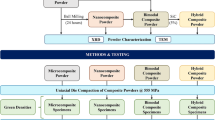Conclusions
-
1.
Specimens of composite material based on niobium carbide obtained by hydrostatic pressing had minimum porosity compared with specimens obtained by the normal powder metallurgy method.
-
2.
Basic phases of the composite material consisting of copper and niobium carbide are uniformly distributed throughout the specimen cross section and they do not react with each other under any conditions.
-
3.
The composite material obtained exhibits sufficient resistance to thermal shock and it is not subject to brittle failure which is typical for similar type materials obtained by other methods.
Similar content being viewed by others
Literature cited
S. A. Tsukerman, Powder and Composite Materials [in Russian], Nauka, Moscow (1976).
V. S. Bogomolov, "Study of the properties and structure of heaters based on NbC," Poroshk. Metall., No. 3, 92–97 (1982).
G. V. Samsonov (ed.), High-Temperature Carbides [in Russian], Naukova Dumka, Kiev (1975).
L. F. Vereshchagin, Synthetic Diamonds and Hydroextrusion [in Russian], Nauka, Moscow (1982).
Additional information
ZIL Factory Higher Technical School. Translated from Metallovedenie i Termicheskaya Obrabotka Metallov, No. 8, pp. 26–27, August, 1984.
Rights and permissions
About this article
Cite this article
Ploshkin, V.V., Ul'yanina, I.Y. & Filonenko, V.P. Possibility of obtaining monolithic composite materials based on niobium carbide. Met Sci Heat Treat 26, 596–598 (1984). https://doi.org/10.1007/BF00707798
Issue Date:
DOI: https://doi.org/10.1007/BF00707798




